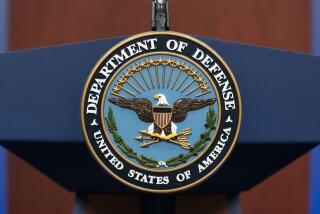U.N. Approves Large Force for Somalia : Peacekeeping: It will take over from U.S.-led troops May 1 and seek to disarm factions, help rebuild ravaged nation.
- Share via
UNITED NATIONS — The Security Council voted Friday to set up the largest and most powerful peacekeeping force in U.N. history to feed the starving, end fighting and rebuild Somalia.
The decision to send 28,000 troops to the African nation will be welcome news to American soldiers who have been patrolling Somalia since December and were frustrated that former President George Bush’s prediction of a quick in-and-out operation proved to be overoptimistic.
Under an ambitious U.S.-drafted resolution, adopted unanimously by the 15 Security Council nations, the U.S.-led Operation Restore Hope will be turned over to the United Nations on May 1.
The U.N. Somalia operation, estimated to cost $1.5 billion during the first year, authorizes troops to do whatever is necessary to maintain peace, disarm the warring factions and protect relief workers.
The largest U.N. operations to date have been in the former Yugoslav republics, where 23,000 U.N. personnel are deployed, and in Cambodia, where 22,000 military and civilian personnel are stationed.
In Somalia, the world body will repatriate hundreds of thousands of refugees, clear land mines, set up a civilian police force, create political institutions, create jobs, rebuild the economy and conduct peace talks on a future government.
U.S. troops went into Somalia on Dec. 9 to ward off famine in the central and southern parts of the country. Contingents from more than 20 countries joined in a force that numbered 37,000 troops at its peak.
U.S. officials had repeatedly accused the United Nations of dragging its feet in taking over the operation. U.N. officials countered that they wanted the Americans to restore order first and needed time to design a comprehensive, long-term operation.
In Somalia on Friday, U.S.-led forces sent aircraft roaring over the southern port of Kismayu to warn rival Somali warlords to stay out of the town. The display of aerial might was a prelude to a broad, two-day sweep of the city and the surrounding countryside starting today by about 2,000 allied soldiers.
They will push out of the city toward the encampments of two rival warlords, Mohamed Siad Hirsi, known as Gen. Morgan, and Omar Jess, who both claim Kismayu. A spokesman for the coalition forces said they do not expect armed opposition, but want to demonstrate the coalition’s resolve to enforce the peace in southern Somalia.
Secretary General Boutros Boutros-Ghali, who proposed the May 1 transfer to the Security Council earlier this month, is asking the world to send 20,000 combat troops and 8,000 support troops, taking over in phases from the U.S.-led force.
The United States is expected to provide the bulk of the support troops and a quick-reaction force. Defense Secretary Les Aspin has said the total American contribution will be 3,000 to 5,000 troops.
The Americans are insisting that the quick-reaction force be under the U.S. Central Command so it cannot be used by the U.N. commander in Somalia acting alone.
The U.N. force, under the command of Turkish Lt. Gen. Cevik Bir, will operate under more powerful rules of engagement than earlier U.N. operations. It is based on Chapter 7 of the U.N. Charter, which authorizes using force when international peace and security are threatened.
Generally, U.N. peacekeepers are allowed to shoot only if fired on first. As a result, they avoid confrontations and rarely intervene.
American troops now in Somalia are allowed to shoot first if they feel threatened.
More to Read
Sign up for Essential California
The most important California stories and recommendations in your inbox every morning.
You may occasionally receive promotional content from the Los Angeles Times.













